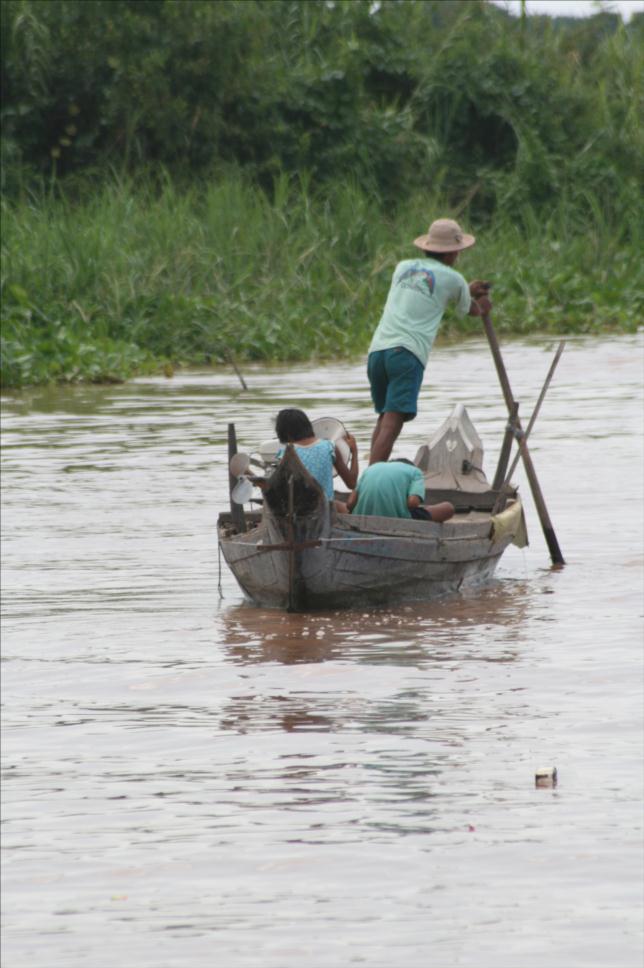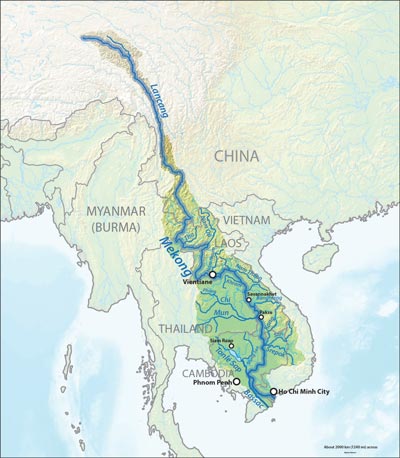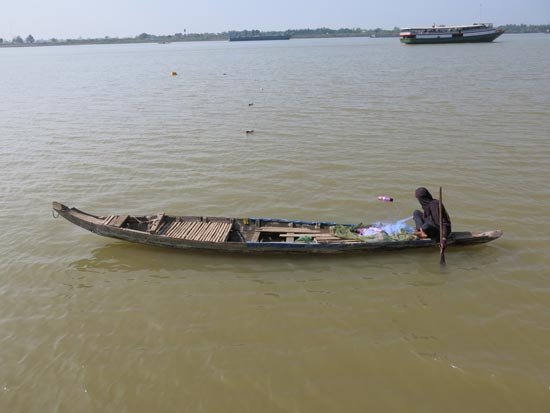The Mekong river
With around 4350 km long and its basin of 800 000 km2 , the Mekong is the longest river and the largest in Asia. It originates in Qinghai, which is located on the heights of the Himalayas and flows finally into the sea of the Pacific. In all, he has passed through six different countries: China, Laos, Burma, Thailand, Cambodia and finally southern Vietnam.

It forms a natural border between China and Burma, Burma and Laos, and Thailand and Laos, which results in an incredible biodiversity and history not always quiet.
I- Geography :
The source of the Mekong and therefore its length is unknown at present , due to the existence of several tributaries in a difficult environment access (rough terrain). Estimates range from 4 350 to 4 909 km. However, nearly half of its total length flowing in China. He left the country at an altitude of only 500 m.
The river forms the border between Burma and Laos 200 km , at the end he joined duquels its tributary Ruak in the Golden Triangle. This place also marks the separation of high and low Mékongs .
The Mekong River is the border between Thailand and Laos before continuing crossed into Laos. It expands and gains depth south of the city of Luang Prabang with being very choppy water. Then it becomes the border between Thailand and Laos being close to Vientiane ( capital of Laos) . Then returns the Mekong in Laos , where it forms the region of Si Phan Don ( “Four Thousand Islands ” ) before the Khone Falls near the border with Cambodia .
In Cambodia, the river passes through the Sambor rapids above Kracheh the last snowfall to prohibit navigation. Just before Phnom Penh, Cambodia’s capital , is the confluence with the Tonle Sap, the largest tributary in the country. After the capital is divided into two, the Bassac and the Mekong River itself , and both end up in the Mekong Delta.
In Vietnam, the river divides into two main branches and then throw in the South China Sea by nine estuaries, thus explaining the name of the river “River of Nine Dragons“.
About 90 million people live in the Mekong region . Not less than 140 000 km ² of rice is grown in the region making it a producer of choice.
II -Economy :
The region of the Mekong , which includes Cambodia, China , Laos, The Myammar , Thailand and Vietnam, is approximately 300 million people , 2.6 km of land and a PBI valued at $ 900 million in 2010.
In 1990, after the end of the civil war in Cambodia, the political relations between the countries still remained tense and trade was very limited. However, relative peace reigned and reforms in the countries of the region have contributed to the rapprochement of the countries. Thus, the prospects for economic development have resulted in the final program of regional economic cooperation in 1992 creation.

The primary objective of this program was the development of basic infrastructure that would be able to help connect the country together and develop the resource base of the Mekong. Transport and energy the first buildings were improved , which helped as accelerated the exchange of resources and the movement of people between the neighboring countries. Other sectors benefited from this program to grow, such as telecommunications and tourism. Now, travelers who visit countries Mekong benefit for most of their stay to see 2 see 3 countries at the same time, and Cambodia to gain many visitors through this program.
The program of regional economic cooperation Mekong was a springboard for Cambodia, which is slowly recovering from its long and tragic civil war. The country was destroyed and everything was to be remade, and economic opportunities posed by the reconstruction of the country would soon attract foreign investors, especially those from neighboring countries.
The Mekong River has always been an important economic source for Cambodia. The temples of Ankor, the number one tourist destination in the country, would never have been built without the river. A large majority of the population still lived resources of the river , either by fishing or rice.
It would be interesting for the Development of Cambodia to invest in rice farming and marine tourism. Indeed, the commercial fishing that fish is becoming increasingly rare. In addition, marine tourism could help the country become aware of the need to protect the river, which is now threatened.
Today, aware of its economic and geopolitical potential, the Mekong attract investors who build dams to divert water from the river. The result is that the living conditions of the local population is deteriorating. Sinners , who live in floating villages just dorénavent to meet their needs and that endangers entire families.
In addition, these barragent represents a risk to the environment , as we shall see below .
III- Environment
Overexploitation of the environment is a major problem in this part of the globe . On the Mekong, it is mainly the downstream dams problematic , both in terms of wildlife, excursions for people with flood risks they can cause .
China has built a bridge downstream at Manwan and a second is under construction Dachaoshan. In addition, twelve other construction projects of dams are being studied.
One of the most dependent countries of the Mekong Cambodia, its economy and its food self-sufficiency. The annual floods provide the water that is so precious in this dry country, and meet the Tonle Sap Lake. All major cities are prone to flooding. The Mekong River Commission accuses China of not worrying about its downstream neighbors with many dam projects on the river. Since the construction of the first Chinese dam, many species are now in danger of extinction, such as dolphins and manatees Mekong. The river level has dropped, since the fish caught are smaller and less numerous. Chiang Rai port operates at a quarter of its normal activity, and navigation between Chiang Rai and Luang Prabang takes two days instead of half a day, lack of sufficient water level.
China, because of its lax laws and weak enforcement of environmental laws may increase water pollution and block fish migrations of the Mekong River through the creation of new dams. These will also change the current strength in speed or on the contrary, slow. Cambodia is the country most at risk, but also the most dependent on currents and flooding on specific locations. The fear of famine, as if it had decimated the Angkor civilization there 700 years is still present. All major cities in Laos are on the river, as well as the largest city in Vietnam , Ho Chi Minh City , which may be affected by the current inadequate and pollution. Even Thailand is not safe , since 2010, the Mekong has reached its lowest level in 20 years , the population was beginning to experience water shortages.

Humans are not the only ones threatened by these dams. The river hosts more species of giant fish than any other river , including the giant Mekong catfish. The biggest fish of this species sin in 2005 weighed 293 kg Mekong. Since 1997, scientific expeditions have revealed a large number of new species. Thus, since the first edition of the Greater Mekong, published annually since 2007 by the NGO WWF, more than 1,700 species were newly described. In 2010 alone, no less than 208 species have been discovered, most of which are endemic. According to the report, the fieldwork revealed, among other things, a new monkey family rhinopithèques, 28 reptiles, including a lizard only female capable of self – reproduction and a gecko with psychedelic colors, a tiny bird green and yellow forest, 7 frogs and fish 25. Although this region is one of the world’s richest in biodiversity, it is no less threatened, mainly because of the disappearance of species habitat. Of large-scale infrastructure projects such as dam Xayabury in northern Laos, pose serious threats to ecosystems .
We can then ask whether the Mekong commission could play a role in curbing the occurrence of these dams and well preserved ecosystems of the Mekong.